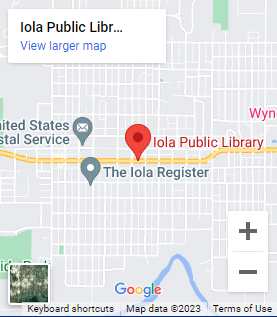History
Historical Information About the Iola Public Library
Iola Library Association, 1884 – 1905
Iola Public Library, 1905 – Present
The library was founded as a membership library in 1884, then became a free public library in 1905. Both centennials were celebrated, in 1984 and 2005.
Iola is lucky in that the library board requested Lewis Henry Wishard to write a history of the library. He did so, and this book preserves much library history that might otherwise have been lost. The library has several copies of this volume, which he wrote in 1929, with some supplements up through 1934. Mr. Wishard was the first president of the library board when the library became a free public library in 1905. He served on the library board for approximately 30 years, most of the time as its secretary. He was evidently a rather curmudgeonly sort, and his droll humor and caustic remarks make the book much more entertaining reading than you might imagine. His story of how he maneuvered George Bowlus and others to contribute more land for the library than they had first intended is another example.
The first mention of a movement to organize a library is found in the Iola Register in March 1879, which reads, “An effort is now being made to organize an association for the purpose of starting a public library. We sincerely hope it will be done…Any feasible plan will meet with our hearty approval, and to the work we pledge all that we can do…The town needs a library, the people need it; a strong, hearty pull altogether and we will have it.”
However, it was to be five years before an association really got off the ground. At a meeting in the Opera House in July 1884, the Iola Library Association was organized. Judge Talcott sent a message to the meeting offering the donation of a number of books if a public library was organized, which was accepted with thanks. The library has the association’s charter and a minutes book which begins with that organizational meeting and continues up to 1900.
The library opened by the Iola Library Association was not yet a public library as we think of today. Rather, it was a membership organization and charged fees for reading and checking out books. The Iola Library Association had 83 members who paid $1 each in dues. Members received a share of stock showing their membership (see photo).
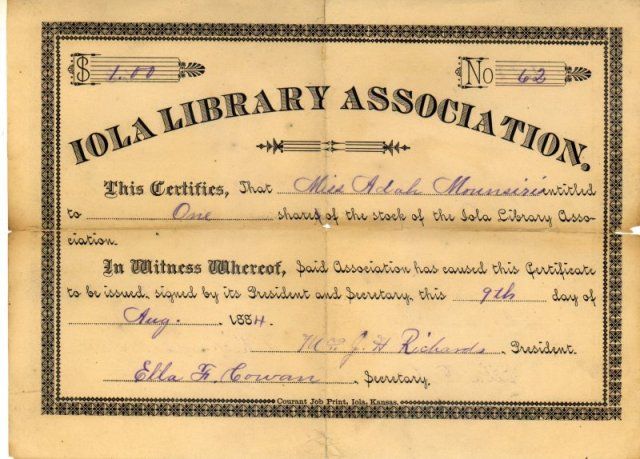
Members could obtain the privilege of reading and using books belonging to the library by paying an additional 25 cents per quarter. Non-members could pay 10 cents per book in order to check out a book.
The Iola Library Association elected officers, including seven members of the board of directors, a 12-member board of trustees, a library staff of three members, two Vice Presidents, a secretary, a treasurer, a librarian, and an assistant librarian. 30 officers in all. Mr. Wishard in his book comments “It seems that there were almost, if not quite, enough offices to go round. This society was most thoroughly officered”
The notion of electing a librarian seems strange today, but an annual election of a librarian continued at least up through the mid-1930s. The first librarian was Miss Nettie Scott, who served for four years. After she resigned, nine people applied for the position. Upon consulting the bylaws, however, it was discovered that all officers had to be chosen from among the membership of the board of directors. Mrs. W.M. (Virginia) Knapp being the only applicant who fulfilled that qualification, she was unanimously elected to the post. Mrs. Knapp remained as librarian until the library was reorganized as a city library in 1905, then served an additional 22 years on the library board.
L.L. Northrup provided space over the bank rent free for the library, and continued this when a new bank was built. Later on the library moved to quarters over Ramsay’s store, then over Brown’s drug store.
The library still has several books from the Iola Library Association era with the association’s book plate in the front. This plate showed ownership, an identification number for the book, and the library rules and regulations (see photo). There is also a printed catalog of the library’s holdings from 1889.
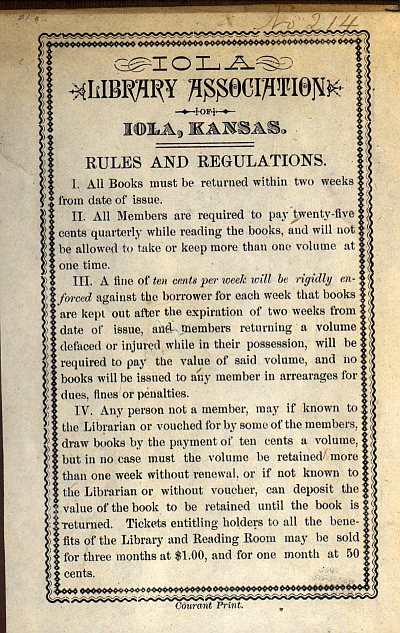
With no reliable source of income, the library was supported mainly by memberships, reading fees, and constant fundraisers. The fundraisers included lawn socials, pantomimes, tableaus, charades, glee clubs, concession stands at fairs and 4th of July celebrations, dinners served on election days, dramas, literary and musical entertainments, soap bubble parties, masquerade social, chrysanthemum shows, pink teas, and other events. At pink teas, sassafras tea was sold. Those who paid to attend had a pink cloth letter T pinned to them to show that they had paid. When the Friends of the Library was organized around 1984 to help celebrate the centennial of the library, one of the events they held was a pink tea. When the centennial of the public library was celebrated in 2005, a Pink Tea was held again.
By 1904 the limitations of a subscription library, which relied totally on membership fees and fundraisers for financial support and had no building of its own, was clear to the residents of Iola. There was a desire to form a tax-supported free public library.
Andrew Carnegie, who had made a fortune in steel, was interested in the development of free public libraries across the country. He had begun to use much of his fortune to pay for public library buildings in communities that would agree to provide ongoing tax support for the library amounting to at least 10% of the capital cost of building the library. The mayor of Iola, E.W. Myler, wrote to Mr. Carnegie requesting funds to build a library. Mr. Carnegie agreed to donate $15,000 if the city would establish a free public library and support it with at least $1500 annually. The city commission placed the question of establishing such a library on the ballot for Feb. 14, 1905. The residents by a large majority, over 77%, voted themselves a Valentine’s Day present of a free public library.
A library board was appointed and got right down to the business of getting the building underway. There was some competition over location, with the offer of a free site on south Washington and another on east Madison. By a vote of 7 to 5, the board voted to accept the east Madison offer, with all board members living on the west side of town voting for south Washington and all board members living on the east side of town voting for east Madison. The donors of the land were four town boosters: George Bowlus, J.A. Robinson, A.W. Beck, and H.L. Henderson.
The board decided to erect a concrete building (see photo). By looking at the picture, if you hadn’t visited the Carnegie library, you might think it was stone. It was made to look that way, but it was actually a concrete building. It was built at a cost of $14,980 and opened in October of 1906. The library contained living quarters which were used first by the librarian and later by the janitor.
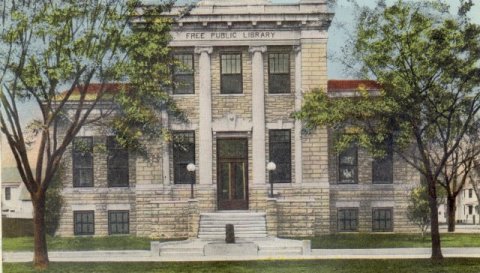
Along with the building, the board had to vote on a librarian. Virginia Knapp had been librarian for 17 years with the Iola Library Association and wished to continue, but the board voted instead to hire Nannie Armstrong. She was paid $50 per month and given the use of the library living quarters. Mrs. Armstrong was given the task, while the building project was underway, of canvassing the city for book donations or cash donations for the purchase of books. Before long, she had in hand $225 and over 1000 books, most of which were kept and added to the 2000 volumes the Iola Library Association already owned.
We have a small pamphlet (see photograph) outlining the rules of the library from 1912 which makes kind of interesting reading. The library hours were 9-11 and 2-9 daily, so the library was closed three hours during the middle of the day. Non-residents of Iola paid $1 per year for a library card, and transient users paid a $1 deposit or the cost of the book they wished to borrow. This money was refunded when the book was returned, except for 5 cents per day for the use of the book. There was a limit of two books checked out, provided that one of them was nonfiction. New fiction books were seven day books and the rest fourteen day books, which did not change until 2008, when new fiction also became fourteen day books. When the library purchased more than one copy of a book, the additional copies were put on a Pay Shelf, where users paid 5 cents per week until the cost of the book was paid off, at which time it was transferred to the general collection. Fines were set at 2 cents per day.
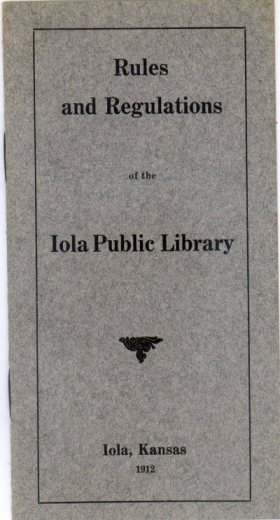
During a smallpox epidemic in 1922, the library stopped circulating books until the epidemic subsided.
Between 1905, when the free city library began, and 1927, the library had three different librarians, two of whom left with mutually bad feelings on the part of board and librarian. In 1927, the librarian gave the board what amounted to an ultimatum about what it should do, or she would resign. The board didn’t take kindly to this and accepted her resignation. The board had become largely inactive, meeting only 8 times in three years, but this event reinvigorated the board and the library. To replace the resigning librarian, the board hired Luella Varner in 1927, who served for the next 31 years. The next several years were an especially fruitful period for the library. Luella Varner had a positive impact on the library from the first, and Wishard wrote of her in 1929, two years after her hiring, that “never before has Iola had a librarian with the education and preparation for this work like the present one. Miss Varner is gradually bringing the library into its own. Children now come to the library because they love her, and older people come because they know they will be greeted with a smile of welcome. The attendance and use of the library grows with each passing month and the Board believes they have made a real find.”
Part of what made the board member say this was the increasing use of the library, the instituting of a children’s storytime during the summer, and the development of a Kansas Room. The Kansas Room (see photo)
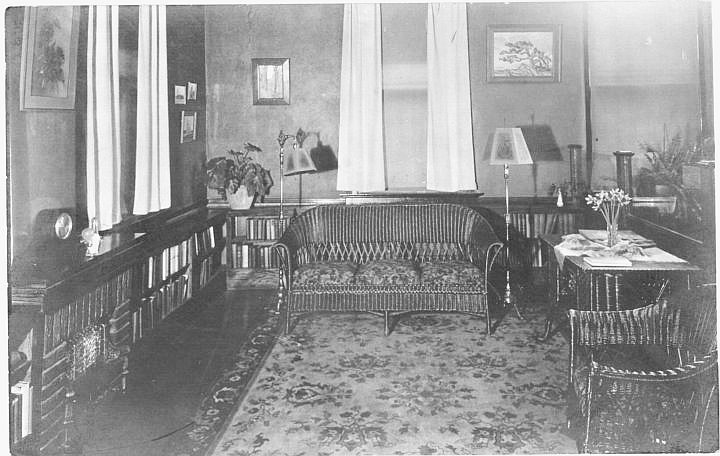
was carved out of the northeast corner of the library by building partitions of oak panels and plate glass. A fireplace, comfortable furnishings, and art work made the room and appealing one, and the shelves were stocked with books about Kansas or written by Kansas authors. The room was almost entirely built and furnished through donations. It was officially opened on Kansas Day in 1929, and an art exhibit featuring Kansas artists was held in connection with the opening. Thomas Bowlus purchased one of these paintings, the Birger Sandzen painting Timberline at Twilight as a donation it to the library. The painting now hangs in the hallway, around the corner from the coffee area.
The outside of the library came in for some attention, too. A lily and fish pond was added in 1928. Sometime not long after that the rock pile was added. (See photo). Longtime library board member Lewis Wishard began this rather unusual addition to the library with a boulder, and decided it should be surrounded by decorative rocks from all over the United States. A Rotary Club member, Wishard got fellow Rotarians to help collect and fund the rock pile. This sparkly conglomeration of rocks was floodlit at night.
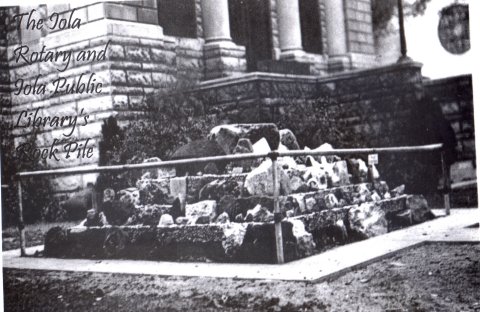
At the time, only residents of the city of Iola could use the library without paying a fee. In 1929, the Lehigh Portland Cement Company made a $200 donation to the library, in return for which residents of Bassett were allowed to use the library for five years with no fee.
A few years after Luella Varner was hired, the Great Depression hit. It’s a little difficult to gauge just how profoundly the Depression affected the library. One indication of the library’s declining finances was the decision in 1933 to reduce Miss Varner’s salary by 10%, from $1500 per year to $1,350. It has frequently been stated that libraries were heavily used in the 1930s, because people couldn’t afford other types of entertainment. That seems to hold true in Iola; between 1930 and 1933, circulation increased by about half, from 30,000 to 45,000.
Libraries are always changing. Even in the midst of the Depression, you find this. In 1935, for example, the library first instituted a practice that has continued to this day. Separate shelving was installed for westerns and mysteries, two categories of fiction that had been somewhat suspect to many. Wishard comments that the separate shelving was “possibly so the hair-raising influence of these books will not influence by close contact the books usually read by readers more sober-minded than these others”.
A revision of library rules was made in 1939. Most rules remained the same as from the 1912 rules mentioned earlier. There are a few differences, however. The library did not open until 2 p.m., rather than being open in the morning, probably because the Depression necessitated a cutback in hours. The requirement that if two books were checked out one of them had to be nonfiction was dropped. Two additions to the rules are that no reserve lists for books were to be made, and a section on contagious diseases was added. Contagious diseases in homes where there were library books were to be reported so fines could be stopped. In cases of scarlet fever, the attending physician was requested to burn the books. In the case of other diseases, the books were to be returned as soon as the homes, including the books, had been fumigated. This rule may have been prompted partially by that smallpox epidemic mentioned earlier during which the library had stopped circulating books.
By the 1940s the library was beginning to outgrow its building, and the building was showing signs of deterioration. Sometime during this period, the library living quarters stopped being used for the janitor, and the space was converted to other uses. The children’s department was enlarged in 1953, and the main reading room remodeled in 1955. Sometime before 1955 space problems led to the dismantling of the Kansas Room. The Kansas collection that had been contained there was moved to the mezzanine. The library celebrated its 50th anniversary in the Carnegie building with a reception in 1956. Luella Varner retired in 1958 after 31 years as librarian, and Lucile Wagner was hired.
One of the big challenges of Lucile’s period as library director was what to do about the deteriorating library building. An engineering company’s report on the building in 1961 concluded “The condition of this building should be classified as unsound if not dangerous and all economic efforts should be directed toward vacating this building rather than restoring it.” In 1965, a bond issue for building a new library was held. Prior to the election there were a number of articles in the Register, as well as many ads sponsored by businesses supporting a new library. One of the most effective was no doubt one which showed Lucile Wagner with her hand inserted into a crack between the wall and the floor. The election carried by a margin of more than 3 to 1.
Another major event in the library’s history was happening simultaneously with the planning for and construction of the new library. The Legislature in the mid-1960s authorized the establishment of seven regional library systems. Happily for Iola, circumstances combined to cause the southeast region to be headquartered here. These circumstances included the fact that a new library building was being built which could be planned with the regional system in mind, and that Iola was one of only two southeast Kansas communities whose librarian had the required master’s degree in library science. While it wasn’t a foregone conclusion that regional systems would be located in public libraries, or that one person would serve as director of both the public library and the system, it did make a good deal of sense to do it that way, and several regions, including southeast, did do this. Lucile was very active in getting the regional system organized, visiting with every library board in southeast Kansas to promote the idea.
For about a year, while the new library was being constructed, the library was housed in the North Community Building. The new library was dedicated in May 1967 with considerable fanfare. Governor Docking was in attendance, as was Luella Varner, the retired longtime librarian to whom the building was dedicated.
The size of the building had been cut back from initial plans before being submitted to a bond election. Consequently, the new library was only a little larger than the Carnegie building it replaced, although with the design and having everything on one floor the usable space was greatly increased. Nevertheless, two additions have been made, one in 1971 and one in 1985, neither with any tax money involved. The 1971 addition was a small addition to the west, built with donations, and housing the SEKLS rotating book van and other SEKLS offices. Some time later the children’s room was also expanded into this addition–the back part of what’s the children’s room now. The 1985 addition was a much larger addition built primarily for the Southeast Kansas Library System’s offices, and paid for by money given to the library by the Southeast Kansas Library System supplemented by a federal grant. This 1985 addition allowed the whole area that now contains the genealogy and reference sections to be opened up to public use. Previously it had been office and work space.
The library’s first nonprint collection was the LP record collection, begun in the late 1950s or early 1960s. The 1980s saw the addition of art prints, videos, and books on tape. In the 1990s came CDs and CD-ROMs. DVDs were added in 2002 and books on CD in 2003. Playaway audio books came in 2009.
Computers came to the library in the 1990s. In 1991, the conversion to automated records began, and the card catalog was closed. Although it remained until the automation project was substantially complete, cards were not put it in for new items. The conversion to an automated circulation system was made in 1994. The library’s first public Internet computer was in 1996. In 1999, a networked broadband connection was put into place.
Another major development was joining the SEKnFind consortium in November 2008. The library’s catalog and circulation system is a shared one with 46 other southeast Kansas libraries. This system provides many benefits to users. It can be searched either from the library or from home. Patrons can log into their accounts to see what books they have checked out, renew books, place holds, write book comments, and make purchase suggestions.
A bond issue for an expansion and major renovation of the library was placed on the ballot in 2002, but failed, receiving 43% of the vote. In 2010-2011, the library was renovated due to the City of Iola receiving a Community Development Block Grant for that purpose. Major features of the renovation included creating a meeting room, constructing a vestibule on the west end of the building for entry into the new meeting room, building a new circulation desk and re-locating it; new and more energy-efficient lighting throughout the building; renovated restrooms to make them ADA compliant; some new windows and doors; a new roof over the original portion of the library; new paint, carpet, tile, and ceiling tiles throughout the building; and new end panels, computer tables, and some shelving necessary for the new layout.
A library Endowment Fund was established in 2012, with earnings to be used in the library’s operating budget. A Reading Nook loft was installed in the children’s department in 2017. The library became a passport acceptance facility in 2017. Hoopla Digital service (streaming and downloadable materials) was offered beginning in 2018.
Iola Public Library
218 E. Madison
Iola, Kansas 66749
► Hours
Mon - Thur: 9:00 - 8:00
Fri & Sat: 9:00 - 5:00
Fax (620) 365-5137

